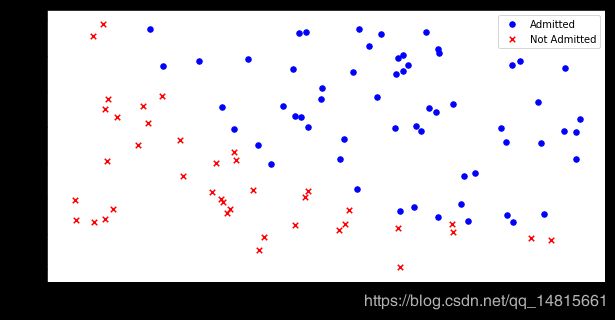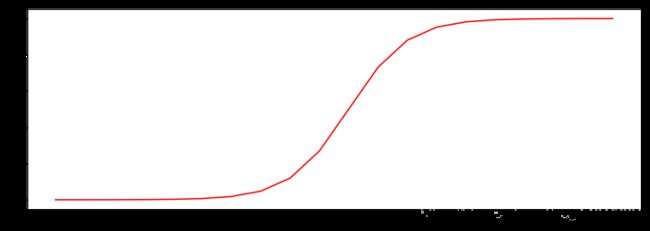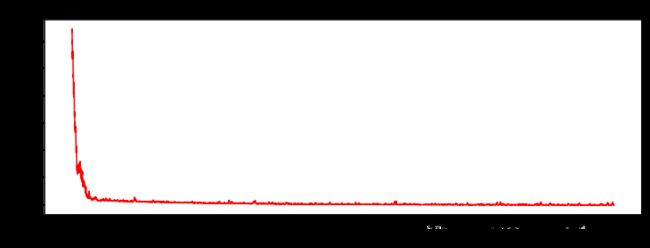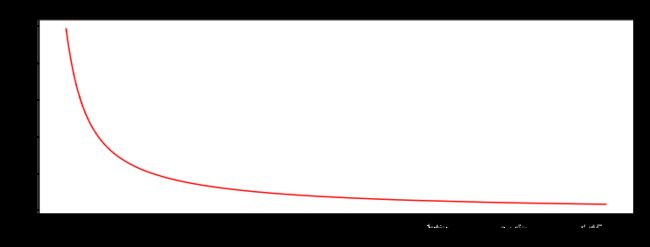机器学习案例实战:Python实现逻辑回归与梯度下降策略
原创文章,如需转载请保留出处
本博客为唐宇迪老师python数据分析与机器学习实战课程学习笔记
一. Python实现逻辑回归任务概述
1.1 问题描述
我们将建立一个逻辑回归模型来预测一个学生是否被大学录取。假设你是一个大学系的管理员,你想根据两次考试的结果来决定每个申请人的历史数据,你可以用它作为逻辑回归的训练集。对于每一个培训例子,你可以有两个考试申请人的分数和录取决定。为了做到这一点,我们将建立一个分类模型,根据考试成绩估计入学概率。
1.2 代码实现
import numpy as np
import pandas as pd
import matplotlib.pyplot as plt
%matplotlib inline
import os
path = 'data'+os.sep+'LogiReg_data.txt'
pdData = pd.read_csv(path, header=None, names=['Exam 1','Exam 2','Admitted'])
pdData.head()
Exam 1 Exam 2 Admitted
0 34.623660 78.024693 0
1 30.286711 43.894998 0
2 35.847409 72.902198 0
3 60.182599 86.308552 1
4 79.032736 75.344376 1
pdData.shape
(100, 3)
#fig, ax = plt.subplots(1,3,figsize=(15,7)),这样就会有1行3个15x7大小的子图。
positive = pdData[pdData['Admitted']==1]
negative = pdData[pdData['Admitted']==0]
fig,ax = plt.subplots(figsize=(10,5))
ax.scatter(positive['Exam 1'],positive['Exam 2'],s=30,c='b',marker='o',label='Admitted')
ax.scatter(negative['Exam 1'],negative['Exam 2'],s=30,c='r',marker='x',label='Not Admitted')
ax.legend()
ax.set_xlabel('Exam 1 Score')
ax.set_ylabel('Exam 2 Score')
- 目标:建立分类器(求解出三个参数θ0θ1θ2)
- 设定阈值,根据阈值判断录取结果
要完成的模块
- sigmoid:映射到概率的函数
- model:返回预测结果值
- cost:根据参数计算损失
- gradient:计算每个参数的梯度方向
- descent:进行参数更新
- accuracy:计算精度
二. 完成梯度下降模块
2.1 Sigmoid函数定义
def sigmoid(z):
return 1/(1 + np.exp(-z))
2.2 查看该函数
nums = np.arange(-10, 10, step=1)
fig, ax = plt.subplots(figsize=(12,4))
ax.plot(nums, sigmoid(nums),'r')
def model(X,theta):
return sigmoid(np.dot(X, theta.T))
pdData.insert(0, 'Ones', 1)
##将表格转换为矩阵
orig_data = pdData.as_matrix()
cols = orig_data.shape[1]#cols=4列
X = orig_data[:,0:cols-1]
y = orig_data[:,cols-1:cols]
theta = np.zeros([1,3])
2.5 查看参数
X[:5]
array([[ 1. , 34.62365962, 78.02469282],
[ 1. , 30.28671077, 43.89499752],
[ 1. , 35.84740877, 72.90219803],
[ 1. , 60.18259939, 86.3085521 ],
[ 1. , 79.03273605, 75.34437644]])
y[:5]
array([[0.],
[0.],
[0.],
[1.],
[1.]])
theta
array([[0., 0., 0.]])
X.shape, y.shape, theta.shape
((100, 3), (100, 1), (1, 3))
def cost(X, y, theta):
left = np.multiply(-y, np.log(model(X, theta)))
right = np.multiply(1 - y, np.log(1-model(X, theta)))
return np.sum(left - right) / (len(X))
2.7 带入计算
cost(X, y, theta)
0.6931471805599453
def gradient(X, y, theta):
grad = np.zeros(theta.shape)
error = (model(X, theta) - y).ravel()
for j in range(len(theta.ravel())):
term = np.multiply(error, X[:,j])
grad[0,j] = np.sum(term) / len(X)
return grad
三. 停止策略与梯度下降案例
STOP_ITER = 0
STOP_COST = 1
STOP_GRAD = 2
def stopCriterion(type, value, threshold):
#设定三种不同的停止策略
if type == STOP_ITER: return value > threshold
elif type == STOP_COST: return abs(value[-1]-value[-2]) < threshold
elif type == STOP_GRAD: return np.linalg.norm(value) < threshold
import numpy.random
#洗牌
def shuffleData(data):
np.random.shuffle(data)
cols = data.shape[1]
X = data[:, 0:cols-1]
y = data[:, cols-1:]
return X, y
import time
def descent(data, theta, batchSize, stopType, thresh, alpha):
#梯度下降求解
init_time = time.time()
i = 0#迭代次数
k = 0#batch
X, y = shuffleData(data)
grad = np.zeros(theta.shape)#计算的梯度
costs = [cost(X, y, theta)]#损失值
while True:
grad = gradient(X[k:k+batchSize], y[k:k+batchSize], theta)
k += batchSize#取batch数量个数据
if k>=n:
k = 0
X, y = shuffleData(data)#重新洗牌
theta = theta - alpha*grad#参数更新
costs.append(cost(X, y, theta))#计算新的损失
i +=1
if stopType == STOP_ITER: value = i
elif stopType == STOP_COST: value = costs
elif stopType == STOP_GRAD: value = grad
if stopCriterion(stopType, value, thresh):break
return theta, i-1, costs, grad, time.time() - init_time
def runExpe(data, theta, batchSize, stopType, thresh, alpha):
theta, iter, costs, grad, dur = descent(data, theta, batchSize, stopType, thresh, alpha)
name = "Original" if (data[:,1]>2).sum() > 1 else "Scaled"
name += "data - learning rate:{} -".format(alpha)
if batchSize==n:strDescType = "Gradient"
elif batchSize == 1: strDescType = "Stochastic"
else: strDescType = "Mini-batch({})".format(batchSize)
name += strDescType + "descent - Stop:"
if stopType == STOP_ITER: strStop = "{} iterations".format(thresh)
elif stopType == STOP_ITER: strStop = "costs change < {}".format(thresh)
else: strStop ="gradient norm < {}".format(thresh)
name+=strStop
print ("***{}\nTheta:{} - Iter:{} - Last cost:{:03.2f} - Duration:{:03.2f}s".format(
name, theta, iter, costs[-1],dur))
fig, ax = plt.subplots(figsize=(12,4))
ax.plot(np.arange(len(costs)),costs,'r')
ax.set_xlabel('Iterations')
ax.set_ylabel('Cost')
ax.set_title(name.upper() + ' - Error vs. Iteration')
return theta
n = 100
runExpe(orig_data, theta, n, STOP_ITER, thresh=5000, alpha=0.000001)

四. 实验对比效果
4.1 根据损失值停止
设定阈值1E-6,差不多需要110000次迭代
runExpe(orig_data, theta, n, STOP_COST, thresh=0.000001, alpha=0.001)
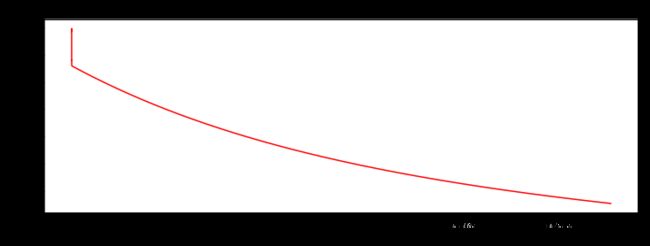
4.2 根据梯度变化停止
设定阈值0.05,差不多需要40000次迭代
runExpe(orig_data, theta, n, STOP_GRAD, thresh=0.05, alpha=0.001)
runExpe(orig_data, theta, 1, STOP_ITER, thresh=5000, alpha=0.001)
runExpe(orig_data, theta, 1, STOP_ITER, thresh=15000, alpha=0.000002)
runExpe(orig_data, theta, 16, STOP_ITER, thresh=15000, alpha=0.001)
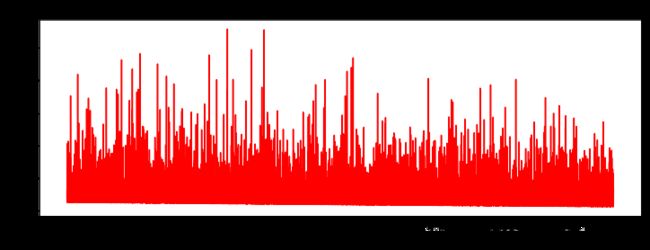
浮动依然比较大,我们尝试对数据标准化,将数据按其属性(按列进行)减去其均值,然后除以其方差。最后得到的结果是,对每个属性/每列来说所有数据都聚集在0附近,方差值为1
from sklearn import preprocessing as pp
scaled_data = orig_data.copy()
scaled_data[:,1:3] = pp.scale(orig_data[:,1:3])
runExpe(orig_data, theta, n, STOP_ITER, thresh=5000, alpha=0.001)
runExpe(orig_data, theta, n, STOP_GRAD, thresh=0.02, alpha=0.001)
runExpe(orig_data, theta, n, STOP_GRAD, thresh=0.02, alpha=0.001)
runExpe(scaled_data, theta, 16, STOP_GRAD, thresh=0.002*2, alpha=0.001)
#设定阈值
def predict (X, theta):
return [1 if x >=0.5 else 0 for x in model(X, theta)]
scaled_X = scaled_data[:, :3]
y = scaled_data[:, 3]
predictions = predict(scaled_X, theta)
correct = [1 if ((a == 1 and b == 1) or (a == 0 and b == 0)) else 0 for (a, b) in zip(predictions, y)]
accuracy = (sum(map(int, correct)) % len(correct))
print ('accuracy = {0}%'.format(accuracy))
accuracy = 89%
